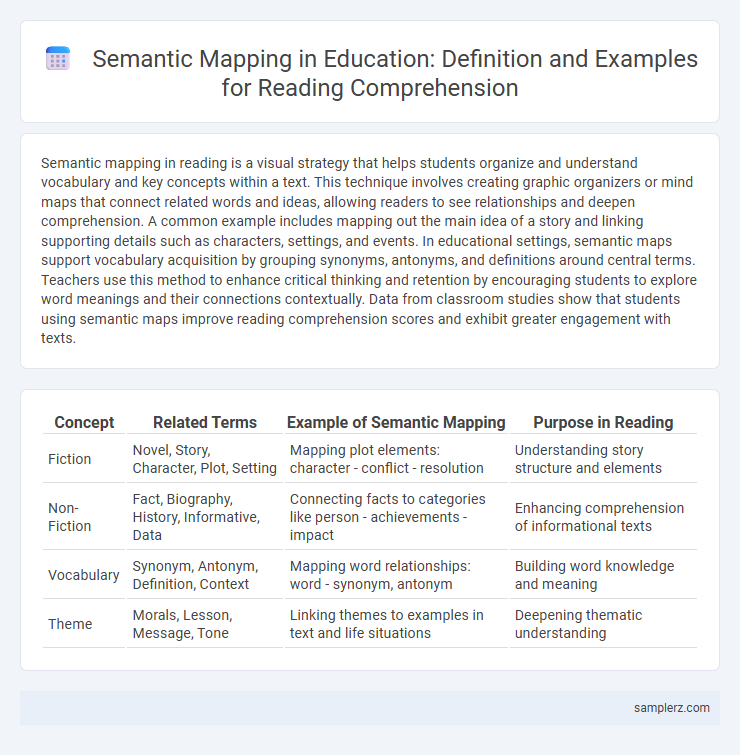Semantic mapping in reading is a visual strategy that helps students organize and understand vocabulary and key concepts within a text. This technique involves creating graphic organizers or mind maps that connect related words and ideas, allowing readers to see relationships and deepen comprehension. A common example includes mapping out the main idea of a story and linking supporting details such as characters, settings, and events. In educational settings, semantic maps support vocabulary acquisition by grouping synonyms, antonyms, and definitions around central terms. Teachers use this method to enhance critical thinking and retention by encouraging students to explore word meanings and their connections contextually. Data from classroom studies show that students using semantic maps improve reading comprehension scores and exhibit greater engagement with texts.
Table of Comparison
| Concept | Related Terms | Example of Semantic Mapping | Purpose in Reading |
|---|---|---|---|
| Fiction | Novel, Story, Character, Plot, Setting | Mapping plot elements: character - conflict - resolution | Understanding story structure and elements |
| Non-Fiction | Fact, Biography, History, Informative, Data | Connecting facts to categories like person - achievements - impact | Enhancing comprehension of informational texts |
| Vocabulary | Synonym, Antonym, Definition, Context | Mapping word relationships: word - synonym, antonym | Building word knowledge and meaning |
| Theme | Morals, Lesson, Message, Tone | Linking themes to examples in text and life situations | Deepening thematic understanding |
Understanding Semantic Mapping in Reading
Semantic mapping in reading enhances comprehension by visually organizing key concepts and their relationships within a text. This technique helps students identify main ideas, supporting details, and vocabulary connections, promoting deeper understanding and retention. Educators implement semantic maps to scaffold complex texts, enabling learners to decode meaning through structured visual frameworks.
Importance of Semantic Mapping for Comprehension
Semantic mapping in reading enhances comprehension by visually organizing and connecting key concepts from the text, allowing readers to better grasp relationships and improve memory retention. This technique supports active engagement with the material, helping students identify main ideas and details through structured, meaningful links. Research shows that semantic maps boost critical thinking skills and facilitate deeper understanding, especially for complex or unfamiliar content.
How Semantic Mapping Enhances Vocabulary Skills
Semantic mapping in reading links new vocabulary to familiar concepts, enabling students to visualize relationships between words and meanings. This technique improves vocabulary retention by organizing information into meaningful clusters, enhancing comprehension and recall. Research shows that semantic mapping facilitates deeper understanding and supports the acquisition of complex language structures in educational settings.
Step-by-Step Guide to Creating Semantic Maps
Creating semantic maps in reading involves first identifying the main concept or theme of the text, followed by listing related keywords or ideas as branches extending from the central node. Next, connect sub-branches that detail supporting facts, definitions, or examples relevant to each keyword to enhance understanding and retention. This structured visualization aids in organizing information logically, facilitating deeper comprehension and improved critical thinking skills in educational settings.
Example 1: Using Semantic Mapping to Decode Informational Texts
Semantic mapping in reading enhances comprehension by visually organizing key concepts and their relationships within informational texts. Example 1 illustrates how students create a semantic map to identify main ideas, supporting details, and vocabulary, enabling deeper understanding of complex content. This strategy promotes critical thinking and improves retention by connecting new information to prior knowledge.
Example 2: Applying Semantic Maps in Literary Analysis
Semantic maps enhance literary analysis by visually organizing themes, characters, and settings to reveal deeper connections within a text. For example, mapping the relationships between protagonists, motifs, and plot developments in Shakespeare's "Macbeth" clarifies underlying themes of ambition and fate. This technique improves comprehension and critical thinking by highlighting implicit narrative structures and symbolisms.
Classroom Activities Featuring Semantic Mapping
Classroom activities featuring semantic mapping in reading include creating concept maps that link key vocabulary and themes from the text, enhancing comprehension by visually organizing information. Students engage in group discussions to categorize and connect ideas, fostering deeper understanding and retention. Digital tools like interactive semantic mapping software enable dynamic exploration of relationships among characters, settings, and plot elements.
Tools and Resources for Semantic Mapping in Reading
Digital tools like MindMeister and Coggle enhance semantic mapping in reading by allowing students to visually organize concepts and relationships between key ideas and vocabulary. Resources such as graphic organizers and interactive whiteboards facilitate active engagement by enabling learners to create dynamic, connected representations of text content. Integrating these technologies supports deeper comprehension and retention through structured semantic connections.
Assessing Student Progress through Semantic Maps
Assessing student progress through semantic maps involves analyzing how effectively students organize and connect key concepts within a text, highlighting their comprehension and critical thinking skills. Teachers can evaluate the accuracy and depth of the semantic maps to identify gaps in understanding and tailor instruction accordingly. This method provides a visual representation of student learning, enabling targeted feedback and fostering deeper engagement with reading material.
Best Practices for Integrating Semantic Mapping in the Curriculum
Semantic mapping in reading enhances comprehension by visually organizing concepts and their relationships, making abstract ideas tangible for students. Best practices include aligning maps with curriculum standards, incorporating interactive digital tools for dynamic learning experiences, and facilitating collaborative map creation to encourage critical thinking. Regular assessment of semantic maps ensures they effectively support vocabulary development and deepen understanding of complex texts.

example of semantic mapping in reading Infographic
 samplerz.com
samplerz.com